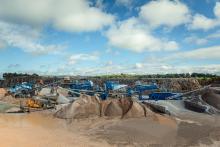James Naish, MP for Rushcliffe, visited the British Geological Survey (BGS's) headquarters in Keyworth, Nottinghamshire, on Monday 16 September 2024, to look at the ongoing installation work of BGS's ground-source heat pump system. He was also given a tour of the National Geological Repository, the largest collection of geoscience samples from the UK.
Work began on the £1.8 million, Government-funded heat decarbonisation project in February 2024. When finished, it will be the largest and most high-tech system of its kind in Rushcliffe, providing new scientific data to the public and will demonstrate how low-carbon heating technology can be applied to both new and existing public sector buildings.
James Naish, Member of Parliament for Rushcliffe, said: "It was great to visit the Keyworth site to hear about how BGS research is actively contributing to addressing pressing environmental challenges but also to see what steps BGS is taking practically to reduce its own carbon footprint.
"As someone who has worked in the energy industry, I passionately believe that the UK needs to embrace new technologies wherever possible so that we have a good, balanced energy mix, and I look forward to working with BGS over the coming years to promote its high-quality research and share its practical learnings from this innovative project."
Scanning of a 240 m-long rock core taken from the site has been undertaken using instruments developed for medical research, providing unique insights on the composition of the ground and the source of natural heat. The results are expected to be published soon, with the installation of the ground-source heat pump system involving 28 boreholes and five heat pumps, providing 360 kW of clean heating power due to be completed by the end of 2024.
Once complete, the project will heat two large buildings and deliver a 'living laboratory'. Equipped with state-of-the-art sensor technology in the boreholes and on the heat pump devices, it will provide data in real-time to help increase both industry and public understanding of ground-source heat pumps and show how they can be an effective solution for heating buildings in the UK.
Karen Hanghøj, Director of BGS, said: "It was a pleasure to welcome James Naish to BGS for the first time and show him around our headquarters in Nottinghamshire. In addition to a tour of the National Geological Repository, we were also able to provide an overview of our exciting new ground-source heat pump installation which will not only help reduce our carbon footprint here on site but provide invaluable geothermal data for the UK as a whole."
The project is majority funded by the Natural Environmental Research Council (NERC) with a further contribution from the Government's Public Sector Decarbonisation Scheme (PSDS). The scheme is run by the Department for Energy Security & Net Zero and is delivered by Salix Finance. The heat pump project is being delivered with partners Cenergist, Welltherm Drilling Ltd and Pick Everard.










